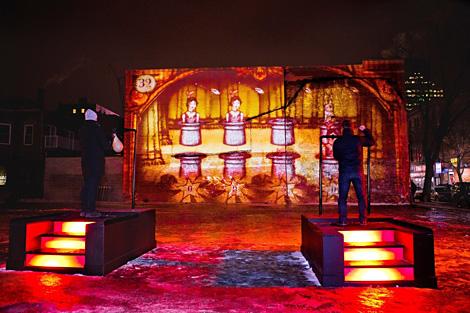Visual designer Matthieu Larivée represents Luz Studio, a Montreal-based firm that provides integrated services in lighting, set design, and video content for clients worldwide. Luz Studio’s Live Design Award is presented to recognize their ongoing creativity for concepts in visual imagery and projection design.
Who has been your biggest influence and why?
Mark Fisher. I have always been a fan of his work, and his ability to fill the space with the scenic elements. That’s why he called his craft entertainment architecture. In my design, I always try to define the area with any given space. My tools are lights, video screens, and set pieces, and my first inspiration for images is often buildings or physical art installations.
What would you say is your biggest achievement thus far?
Lighting the pyramids in Egypt. To have the chance to light the three pyramids and the sphinx within a 1.2-mile canvas was an honor, with such beauty, and it was such a challenge; it was a milestone for me. This is an unusual scale in an unusual environment.

What is your favorite production and why?
Concerts: Nine Inch Nails because of the immersive design. It looks like the design was meant to be. It perfectly reflects the energy on stage and it’s in your face when needed. Theatre: Cirque du Soleil’s KA: It’s unreal. The stage that spins around. Every scene is like a scene from a movie; you get into the journey and lose any theatrical convention.
How did you get into this industry?
Starting to work at a local theatre as a stagehand. I also learned a moving lights console very early so I was able to work with designers and do my own shows very early in the process.
What is your favorite thing about your work as a designer?
What I like about visual design is when it’s cohesive with the artist’s aesthetic artwork that they have on their website. So I like to be part of the project early in the process and try to achieve this 360° feeling. The fact that Luz Studio is designing lights/video/scenic makes this process easier because depending on the project, we decide to proceed with the element that the show needs. For example, if no video is needed, we will use lights and scenic elements to enhance the show look. Sometimes, video is the key element. So we always start with a blank canvas.

Luz Studio at Luminotherapie. Photo by Cindy Boyce
What’s your favorite piece of gear/software/gadget right now, and why?
Specific gear: Barco’s Versatube. Very versatile in stage design, this could either be like “neon,” to create a sharp lighting line, to help define space. Plus, you can map it with video content to create dynamic effects. It’s a shame that they don’t manufacture it. Upstaging has a similar product that looks great: Light Saber. Looking forward to working with it.
For me, media servers are the most useful tools in our designs. They allow us to play with lights and video outside of the box, and get outside the conventional video rectangle frame to come up with more artistic designs, weird angles, and mapping video on any surface allows endless possibilities.
Since we are doing multiple kinds of projects, it changes. The creation process is different when we design a concert than when we do theatre or a corporate show.
The common thing for all projects is to define the black box. What will be our stage, our boundaries? We are always looking for ground-supported ideas that make touring much easier for theatres and clubs. So researching all year long, by reading architecture magazines, by traveling to different cities, and taking pictures to share ideas with the creative staff at the studio.
We get inspired by reading graphic magazines such as IDN and by websites such as Fubiz and Colossal. Technically inspired by reading Live Design, PLSN, LSA, etcetera, and going out to see other shows. We need to be challenged. For music shows, I always start with the artwork and listen to the music. Then we create a mood-board to set the artistic direction.
What advice would you give to young designers just entering the business?
The hardest part for me is to establish a work methodology. The business has become more precise over the years. The preparation is now very important, and we have more technological tools to play with but not more time when we integrate the design with the show. Time is always an issue. Preparation is very important and in the creation process most of the communication is via emails so it’s easier to assume. Don’t hesitate to collaborate with other designers. Having a good team is the key.